Research making a difference 2015




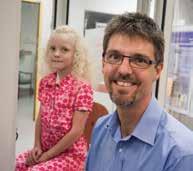















































































































INTRODUCTION FROM OUR DIRECTOR 3 OUR RESEARCH AT A GLANCE 4 SPHERES OF IMPACT ................................................................................... 8 TRANSLATION WHY TINY DUST MITES ARE A BIG PROBLEM 17 VACCINATION TIMING ESSENTIAL ........................................................... 19 NOT JUST A BREAKFAST PROGRAM 21 IMPROVING THE HEALTH AND WELLBEING OF ABORIGINAL KIDS 23 THAT GOOSEBUMP MOMENT 25 HELPING IVF DELIVER HEALTHY BABIES 28 HOMES CRUCIAL FOR HEALTHY EARS ...................................................... 30 NEW TESTS FOR FASD 32 PARADIGM SHIFT SWITCH ON THE IMMUNE SYSTEM EARLY .............................................. 37 TREAT EARLY TO PROTECT LUNGS 40 CHANGING THE FOCUS OF CEREBRAL PALSY 42 A CELL CHANGE THAT DRIVES LEUKAEMIA ............................................. 44 IN THE PIPELINE EARLY DIAGNOSIS FOR KIDS WITH AUTISM 49 LOOKING AT LANGUAGE ........................................................................... 51 A VACCINE TO PROTECT KIDS HEARTS 52 DELIVERING SMART DRUGS INTO CELLS 54
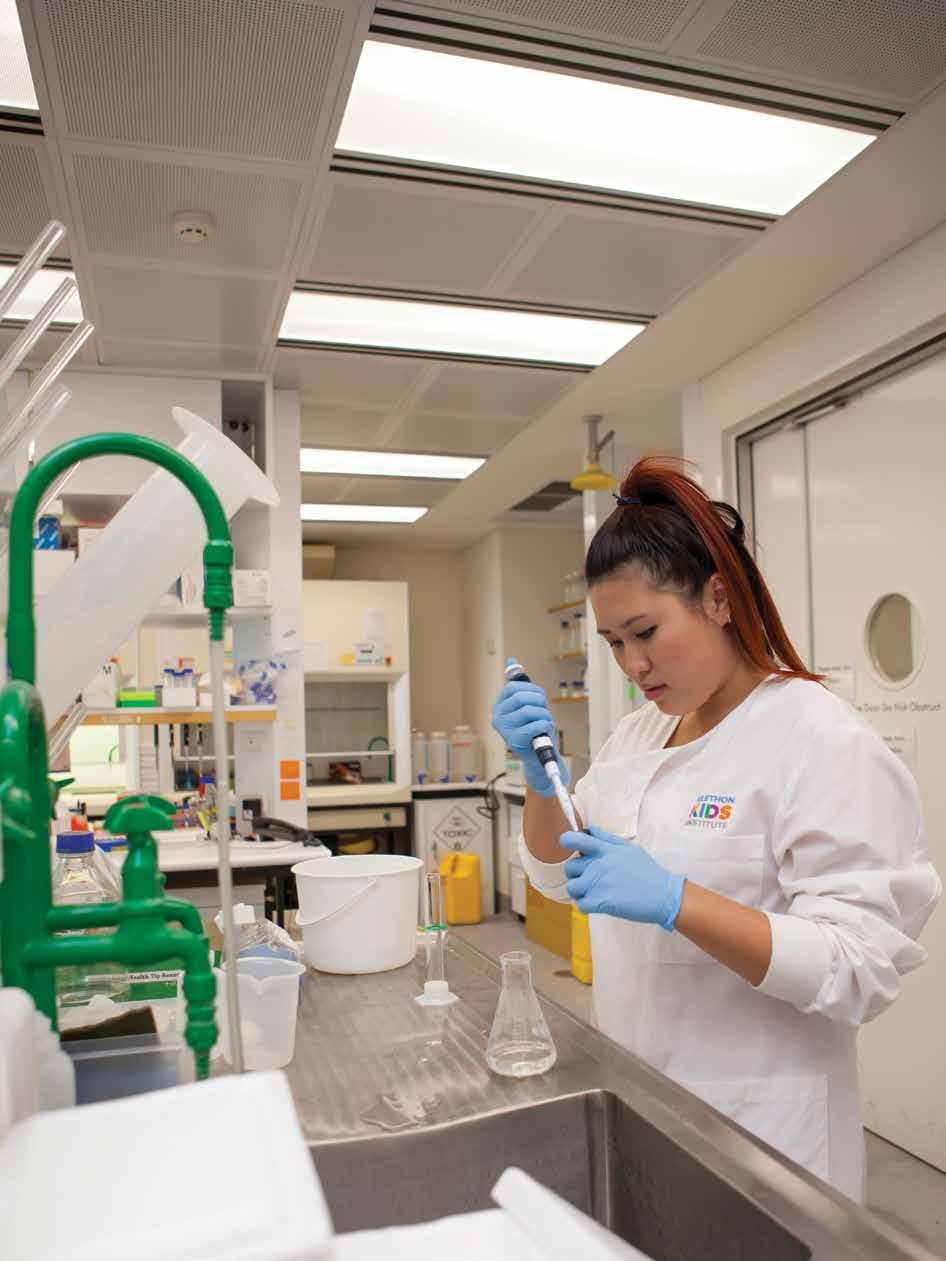




At the Telethon Kids Institute we promised we would do more than cite the usual research metrics of the number of grants won or research papers published.



While these are important indicators, they don’t tell the broader story of how medical research affects policy, practice – and children’s lives.
Nor do they reveal the power of every day discoveries – not the so-called “breakthroughs” but the incremental increases in knowledge that provide the building blocks towards truly understanding the pathways that lead to disease or disadvantage and the opportunities for treatment, intervention or cure.



That’s what’s led us to the publication of our first IMPACT report. It tells the stories of discovery and translational research at Telethon Kids and the real difference that these have made.
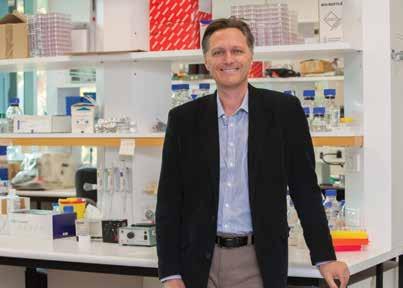
As we celebrate our 25th Anniversary, we’ve used it as an opportunity to showcase some of our past achievements as well as more current projects.
I’m very proud of the important and inspiring work of these researchers, and only a snapshot of what happens here is represented in this report. I hope it will give you an indication of the broad range of our research impact. Indeed there are many more stories that we look forward to sharing with you as we publish this report on an annual basis.
At Telethon Kids, we are committed to a highly collaborative model that involves the community, policy makers, service providers and clinicians in our Research Focus Areas. Collectively we believe our work has and will continue make a big impact on the health and wellbeing of children and families here and around the world.
Jonathan Carapetis Director
RESEARCH MAKING A DIFFERENCE | 3
It’s a question that has long been debated in the research world -how do you measure success?
OUR RESEARCH AT A GLANCE
We have ACTIVE RESEARCH COLLABORATIONS with colleagues and institutes around the world
82

consumer and community members on Telethon Kids committees
89
CLINICAL RESEARCH including trials of new interventions to improve kids health
Asthma
Bronchiolitis
Dermatitis
Cystic fibrosis
Autism spectrum disorders
Gastroenteritis
Cystic fibrosis
Biomarkers of obesity
Diabetes
Vaccines including Influenza, Hib, Meningococcal, Pneumococcal
Allergic disease
Asthma
Diabetes
Obesity
current patents

Infections & vaccines
Ear disease

Language development
Newborn encephalopathy
Obesity
Nutrition
Hypospadias
Asthma













DIAGNOSIS
PREVENTION
THERAPY DEVICE
UNDERSTANDING HUMAN DEVELOPMENT & DISEASE
| IMPACT


































































RESEARCH MAKING A DIFFERENCE | 5
the past 5 years we have received the following RESEARCH FUNDING Australian Competitive Grants Other Competitive Grants Other Grants International Competitive Grants $38.8 M $6.8 M $5.8 M $22.4 M PUBLICATIONS & CITATIONS OVER THE PAST 5 YEARS Telethon Kids is WORKING WITH GOVERNMENT to solve problems in child health REFEREED ARTICLE IN A SCHOLARLY JOURNAL (SOURCE: Telethon Kids data) NUMBER OF CITATIONS (SOURCE: ISI Web of Knowledge) 2013 2012 2011 2010 218 175 171 123 2014 231 5445 4020 3212 2617 6862 papers in the most prestigious journals in the world (impact factor >15) such as Nature and The Lancet. (SOURCE: Telethon Kids data) Includes 31 MILLION TOTAL Services for healthy: pregnancy and birth, children, early years and adolescents Effectiveness Influenza vaccine in young children Fetal Alcohol Spectrum Disorder prevention strategy Child and Adolescent Component of the National Survey of Mental Health and Wellbeing National Suicide Prevention Program Diagnosis/ Screening Instrument for Fetal Alcohol Spectrum Disorders WA lead - National Population data linkage $6.4 M $9.2 M Department of Education & Training Department for Education & Child Development -SA Department of Commerce Australian Agency for International Development Department of Health WA Department of Health & Ageing $8.1 M $26.9 M in government contracts between 2010-2014. Government Departments providing contracts <$400K/5 years have been given a cumulative $ value Chart shows selected examples
Over

Discover. Prevent. Cure
It sounds like a seamless journey, but the reality is far from it. Behind every discovery, prevention or cure is a pipeline of research that is incremental in building the knowledge base.

Rarely is there a “eureka” moment. Often, there are small but significant gains that then need to be tested and replicated.
In the laboratories, our discovery research is unlocking the mechanisms behind how disease develops.
Our population health researchers are identifying patterns, trends and risk factors.
In the clinic, we are understanding how disease affects children and testing new therapies and interventions.
Our commitment as an Institute is to ensure that those research results are translated beyond the shelves of scientific journals into the next steps on that pathway to make a real difference in children’s lives.

Our IMPACT report provides a snapshot of that research process.
This research has been actively translated into policy or practice

This research changed the very way scientists think
And this research is in the pipeline towards translation
This report is a small selection of Telethon Kids research. Find out more about how our researchers are making a difference at telethonkids.org.au
RESEARCH MAKING A DIFFERENCE | 7
TRANSLATION IN THE PIPELINE PARADIGM SHIFT
SPHERES OF IMPACT













Research gains are cumulative and incremental. Each piece of knowledge builds on previous discoveries and successful research rarely happens in isolation.
At Telethon Kids Institute, we are committed to a collaborative model, engaging with researchers at the local, national and international level.
Here we show how Telethon Kids researchers, along with our colleagues from Princess Margaret Hospital and our affiliated universities, are influencing research in some key areas.
Looking at preventions and treatments for respiratory syncytial virus


























RESPIRATORY HEALTH














































8 | IMPACT
Includes:

• Asthma

















































• Cystic Fibrosis



• Influenza







• Whooping Cough






• Respiratory Syncytial Virus







































• Allergy





























• Pneumonia

RESEARCH MAKING A DIFFERENCE | 9
DIABETES & OBESITY




































































































10 | IMPACT
EAR INFECTIONS


















































































RESEARCH MAKING A DIFFERENCE | 11
MENTAL HEALTH, DEVELOPMENT & BEHAVIOUR


Provided the foundations of policy change by contributing to national Government reports:
• Promotion, Prevention and Early Intervention for Mental Health

• A framework for the prevention of suicide and self harm in Australia
• Indicators of social family functioning





























• Provided the first estimates of Aboriginal mental health morbidity


































































• Work contributed to the first National Partnership in the area of Indigenous Early Childhood Education
• National first: Australian Covert Bullying Prevalence Study (ACBPS) - directly impacted state and national school bullying prevention policy and practice (provided the first representative national estimates of bullying prevalence in Australia)




• Findings from the ACBPS contributed to the National Safe Schools Framework as required practice disseminated to all schools in Australia
• Based on our findings national changes were made to cyber bullying prevention and management state policies and practices in schools and government policies (provided the first empirical intervention trial in this area in Australia)
• Findings from the Friendly Schools bullying prevention research conducted from 19992015 changed school practice to view bullying behaviour as a health problem not just a discipline problem.
CHILDREN’S CANCERS




























Includes:













• Leukaemia










• Brain cancer


















• NUT midline carcinoma
• Melanoma

















RESEARCH MAKING A DIFFERENCE | 13


14 | IMPACT
TRANSLATION



RESEARCH MAKING A DIFFERENCE | 15





PROFESSOR WAYNE THOMAS
WHY TINY DUST MITES ARE A BIG PROBLEM
Allergy pioneer Professor Wayne Thomas
For many asthmatics, the microscopic house dust mites that thrive in warm, humid and dark environments are a big deal, producing allergens that can trigger their symptoms.
About 90 per cent of asthmatic children in Australia have an allergy to house dust mites.
The molecular studies of Professor Wayne Thomas, particularly on house dust mites, have provided critical knowledge for the development of new understandings of allergy and new diagnostics and therapeutics.
Professor Thomas joined the Telethon Kids Institute at its inception in 1990 and led the Division of Molecular Biotechnology where he pioneered the use of recombinant allergens for investigation. These were patented for clinical application.
When he entered the field of allergens, several laboratories had started to define the substances that the mite made to cause allergy and determine the chemical structure. However progress was almost at a standstill because they could not be isolated in the quantities required for protein chemistry available at the time.
“My allergen discoveries and developments centred on a new approach that became available in the early 1980s,” Professor Thomas said. “It was to isolate the genes that contained the genetic blueprint for proteins (their amino acid sequences) instead of purifying the proteins themselves in a process called molecular cloning.
“For this, the different genes of the mite were separated and propagated in different colonies of bacteria. This enabled two very important processes - namely the use of DNA sequencing to read the genetic code to identify the proteins encoded by the gene and to make the bacteria produce the protein from the gene in endless quantities (called recombinant proteins or allergens).

“The first house dust mite allergen that I examined in this manner was recognised to be an enzyme that the mite used to digest its dinner. The second was a protein of then unknown function but now known to be critical for immunity to infection.”
They were the first major allergens from any common source to be identified and soon became a subject of undergraduate textbooks.
The central focus of Professor Thomas’ continuing work was to use the molecular approach to define other potential house mite allergens and to measure their contribution to overall allergy response. This found that more than half of allergy of all subjects sensitised by the house dust mite allergens were directed by the first two allergens and that most of the rest were linked to only five other proteins.
Professor Thomas said this molecular identification of allergens and the use of recombinant allergens for diagnosis over the past two decades had been one of the most easily identifiable recent advances in the allergy field.
Recombinant DNA technology provides the means for producing molecules that mimic the properties of the natural allergens and can be used to diagnose and develop desensitisation therapy for allergic people. It has enabled many investigations to help understand how the allergy develops and how it causes disease.
Laboratories elsewhere in the world have used many of these same strategies to move forward with the cloning of pollen, cat, cockroach, fungal and other allergens.



An important discovery made by Professor Thomas with Associate Professor Belinda Hales, the head of the Allergy and Infectious Disease Research Group, was that children with persistent and recurrent asthma, requiring hospitalisation, had allergic responses restricted to the same allergen components as children with mild allergies.
“Our discovery that children with persistent and recurrent asthma lacked the production of protective IgG antibodies rather than producing more of the disease-causing IgE antibodies or responding to more allergens stands out as example of a finding that required the use of pure and recombinant allergens,” he said.
RESEARCH MAKING A DIFFERENCE | 17
TRANSLATION
Professor Thomas said the commercial potential of the allergen cloning and the need to link with pharmaceutical companies was recognised early.
“New diagnostic microchip technologies that allow all common allergies to be simultaneously tested with a single test of a small blood sample require the pure allergens that we produced and their use will further increase when health care funding and insurance arrangements are settled,” he said.
He also said that the therapies in the pipeline that use the knowledge and patents of the cloned allergens are shaping up to make new-generation immunotherapy a reality.
“The efficacy trial of the UK company Circassia Ltd, in particular, showed a short four-injection treatment protocol with allergen components produced rapid relief that was maintained when evaluated two years after the start of treatment.”
Professor Thomas’ interest in cat allergy was sparked by biopharmaceutical firms using this type of allergy as their prototype for developing molecularly-based immunotherapy.
His research has focussed on how individuals respond to different cat allergens and how immune responses to different allergens can interact.
“It has the real advantage over house dust mite in that people allergic to cats can be made to develop symptoms by sitting them in a room with cats, thus providing a real-life assay where the time for development and the severity of symptoms can be measured,” he said.
People had originally thought there was only one allergen.
“Our molecular cloning techniques were applied to define and produce three previously unrecognised allergens made by the cat salivary glands and to show that they were often important components in cat allergy.
“In collaboration with scientists at Circassia Ltd, we then demonstrated that their treatment with one allergen also changed the allergic responses to all the cat allergens - a not unexpected outcome from what immunologists call bystander effects - and this is encouraging for the uptake of the therapy.”

The finding has had important applications in cold-climate regions where companion animals, and not house dust mites, are the major source of allergen for asthma.
Professor Thomas retired from being a research fellow of the National Health and Medical Research Council two years ago but still works as an honorary fellow at the Telethon Kids Institute. He has continued to work with Associate Professor Hales to examine how the immune responses of asthmatic subjects to infections differ from those made by healthy subjects.
What’s next?
Investigation of how changes in the microbiome and infections, such as the common cold, affect asthma will gain momentum.
The examination of new therapies with monoclonal antibodies against specific elements of immune system will take centre stage.
There will be more emphasis on the study of severe asthma using molecular techniques and genetics.
After the recent success of anti-cancer immunostimulants, similar smart immunostimulants will be investigated for allergy and asthma.
Methods and protocols to improve immunotherapy with both extracts and molecularly defined reagents will increase.

The continued use of microchips will make allergy diagnosis more accurate.
About asthma
• Asthma affects about 12 per cent of the population.
• About 20 per cent of both asthmatic children and adults (2.5 per cent of the total population) will have persistent disease that is not controlled with current medication. A quarter will have been admitted to hospital at least once in the past year.
• Hospitalisations, medical visits and asthma deaths have not decreased since 2003.
18 | IMPACT
VACCINATION TIMING ESSENTIAL

We all know how important it is to vaccinate a child against harmful diseases but vaccinating a child at the right wrong age can cost lives.
Professor Carol Bower from the Telethon Kids Institute knows this better than most.
In 1991, she collaborated on a project to assess two infant vaccines against the potentially deadly Haemophilus influenzae type b (Hib) bacterium, which can cause a range of life threatening diseases in young children, including meningitis, epiglottitis, osteomyelitis, cellulitis and pneumonia.
There were two vaccine options on the table at the time - one administered at 18 months of age and several that were administered to infants, beginning at two months of age.

From a cost point of view, it appeared more economical to administer the vaccine after 18 months, however Professor Bower and her research team found it would be grossly inequitable.
At the time 95 per cent of Aboriginal children contracted the Hib infection before they were 18 months compared to 40 per cent of nonAboriginal children


“We found that the vaccine at 18 months of age would be totally ineffective for the 95 per cent of Aboriginal children who contracted their disease before that point,” Professor Bower said.
“We then conducted a separate analysis of the economics of vaccinating Aboriginal children as infants and found that there would in fact be enormous cost savings and many years of life gained if this group of infants was vaccinated earlier.”
“So while administering the vaccine at infancy was more expensive at the outset, the overall long term savings far outweighed that.”
Thanks to Professor Bower and her team’s research, health department policy makers in WA chose to introduce the infant vaccine for all children in January 1993, six months ahead of
its introduction into the national immunisation schedule, and to provide catch-up vaccination for all Aboriginal infants from January 1993.
The new policy saw about an 80 per cent reduction in Hib infection in both Aboriginal and non-Aboriginal children, and a subsequent drop in pneumonia and other complications.
“Further, WA infants had the advantage of six months lead time, which we estimated resulted in 20 fewer infants contracting Hib infection in this period.”
Professor Bower said the introduction of an infant vaccine has protected both Aboriginal and nonAboriginal children from Hib infections and helped to reduce the gap between health outcomes for Aboriginal children.
What’s next?
Surveillance of Hib and other infections continues at the Institute, in WA and nationally, to assess whether other infectious agents (or other types of Haemophilus influenza) might take hold in the niche vacated by Hib infections .
RESEARCH MAKING A DIFFERENCE | 19
TRANSLATION
Protecting kids when they’re most at risk
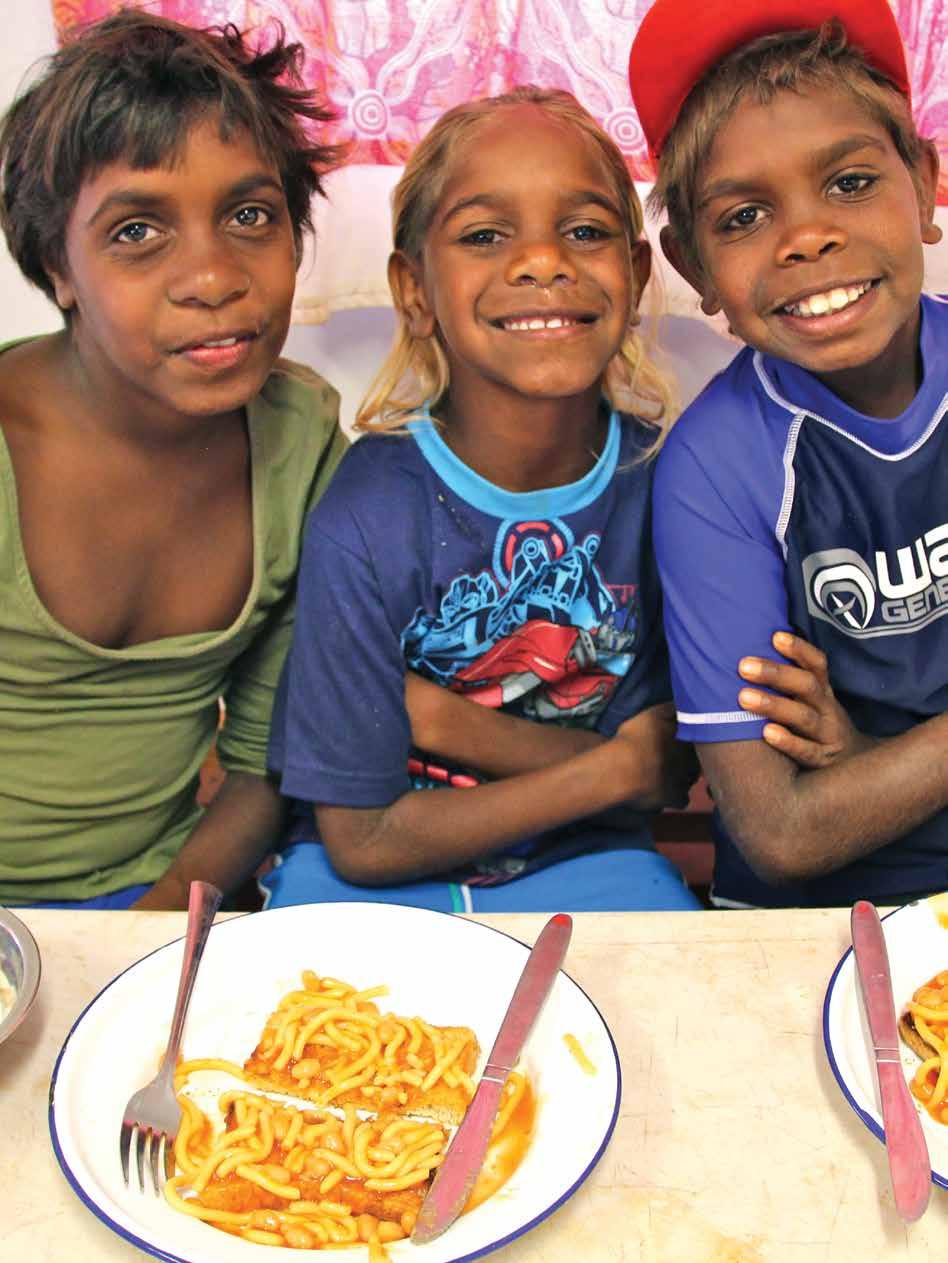
NOT JUST A BREAKFAST PROGRAM Lessons from the WA Aboriginal Child Health Survey
A good healthy breakfast is not just a vital foundation for a productive day but can lay the groundwork for a community to pull together to overhaul its health and wellbeing.
WA’s remote Warburton Aboriginal community showed exactly how, through widespread changes that flowed on from its school breakfast program Milyirrtjarra Kuurl Mirrka Palyalpayi (Making Good Food at Warburton School).
The locally driven program has attracted the attention of the nation for improving not only student attendance and literacy rates over the past decade, but forming strong links between families and the school and inspiring community change.
It was the Telethon Kids Institute’s groundbreaking WA Aboriginal Child Health Survey that provided the “hard statistics” on worryingly low academic attendance and performance and increased risk of behavioural difficulties that the local Warburton Council members needed to successfully lobby to get their breakfast project off the ground.
The women used the data to argue their point, to motivate and win over others and to set up an invaluable community consultation process.
Then at the invitation of Warburton, Telethon Kids Institute staff became actively involved on the ground, 1540 kilometres northeast of Perth, in aiding locals in their efforts to make a difference. In 2008, they formed a collaboration with Ngaanyatjarra Council, the Goldfields District Education Office and the Warburton Remote Community School that was successful in obtaining Australian Research Alliance for Children and Youth (ARACY) seeding grants to establish the breakfast program and trigger the development of other health initiatives. Foodbank WA then provided long-term support which led to a raft of changes.
The research team supporting the Warburton project, comprised of the Telethon Kids Institute’s adjunct Associate Professor Ernie Stringer and Associate Professor Roz Walker and Menzies
School of Health Professor Sven Silburn (formerly from Telethon Kids Institute).
All believed fresh, innovative locally driven projects were needed, as the WA Aboriginal Child Health Survey had concluded that WA education stakeholders needed to stop and reconsider “the types of strategies and programs to overcome disparity”.
This survey, the State’s largest investigation of its kind, involved Professor Stephen Zubrick and his team interviewing 5,300 indigenous children across WA. It highlighted significant concerns for Warburton.
It found that in the Warburton region 73% of students had poor school attendance and 87% of children from Kindergarten to 10-years-old had low academic performance. Also, a higher proportion of Aboriginal students in Warburton were at risk of clinically significant emotional or behavioural difficulties than other indigenous children in WA.



These findings were used by Warburton’s key community leaders and elders to galvanise action among the locals
At the same time, a summary of survey findings and recommendations were presented to key Department of Education policy, administrative and teaching personnel to gain support to revise practices.
At community meetings then held in Warburton to “talk it all through”, it was identified that Warburton needed a dedicated place for parents to establish a link with the school and run language, art and cultural programs. These early consultations led to a “Family Place” being built on school grounds.
“For the past six years the Breakfast ‘Minyma’ (ladies) have continued to extend their activities to provide a range of services and enhance their skills in many ways - demonstrating their ability and capacity to provide for the children’s needs and for the wider community,” said Associate Professor Walker.
RESEARCH MAKING A DIFFERENCE | 21
TRANSLATION
“Community reports confirm that the children’s behaviour has improved as a consequence of seeing greater family and community involvement in everyday affairs.
“The men’s and women’s groups have grown and the importance of meaningful engagement is being perpetuated throughout the community. And the men and women have been able to demonstrate the strength of Ngaanyatjarra families and their continuing successes.”

“The Warburton story is a great case study example of translating the WA Aboriginal Child Health Survey research results with communities and relevant government sectors to make a genuine difference in the lives of Aboriginal children and families,” she said.
What’s next?
“We would like to secure funding to continue to support the community through documenting the evidence of their successes,” said Associate Professor Walker.
“Such a study would be able to show how the development of effective relationships between the school and family members has improved student academic outcomes and social wellbeing as well as increases in health, employment and income, and decreases in substance abuse, violence, imprisonment and mental health problems.”


IMPROVING THE HEALTH AND WELLBEING OF ABORIGINAL KIDS



Ignoring warnings from researchers around the country that “it just can’t be done”, the Telethon Kids Institute created history by surveying one in six indigenous children across the State and collecting vital information on just how this generation was travelling.
“The thing that staggered everybody was that 84 per cent of the indigenous families we approached put their hands up to take part,” said survey leader Professor Stephen Zubrick.”No one could believe that.
“This fundamentally changed the nation’s view. In fact, it was shortly after this that the Longitudinal Study of Indigenous Children for all of Australia was set up.”
Due to this initial widely-held belief of “an element of you’re dreaming”, the Institute had struggled to find a backer willing in 2000 and put up the entire $2 million needed for the landmark WA Aboriginal Child Health Survey. Instead, it had to rely on a patchwork quilt of funding with money from 11 institutions to make it happen.

“The indigenous families put their hands up partly because they trust the Institute,” said Professor Zubrick. “We were also working with Aboriginal people. We had them in our team and we had been to communities to do development work across the State. We listened to them. We said, ‘What do you think?’. We put questions in the survey that they wanted us to ask.“
The four volumes of survey results, based on a random sample of 5,300 indigenous
children from remote, regional and city areas, have driven policy and change. Encompassing a 10 year period, they include the first epidemiological estimates of mental health morbidity.
“We were the first study to show and document that the experience of the Stolen Generation did have an effect on the next generation,” said Professor Zubrick.
”And that has actually been used in courts and human rights settings. Where people have come forward and said ‘We were wronged’, it has been used as evidence that there were real effects and Aboriginal people were not exaggerating or making this up.


“The other point we were able to make is that there is a higher rate of mental illness in Aboriginal children and young people that merits careful attention to the development of services.
“And there was a whole volume written on the educational experiences of Aboriginal children.
About WAACHS
The Western Australian Aboriginal Child Health Survey (WAACHS) was the most comprehensive survey ever undertaken looking at the health, wellbeing and development of Western Australian Aboriginal and Torres Strait Islander children.
More than 5,300 kids from Perth to the most remote communities in WA were involved.

RESEARCH MAKING A DIFFERENCE | 23
TRANSLATION





PROFESSOR CAROL BOWER
THAT GOOSEBUMP MOMENT The journey to folate fortification
To transform a promising decline in a research graph into lives saved and disability prevented takes hard work, determination and a special partnership such as that found between Professors Carol Bower and Fiona Stanley.
They were the driving force behind what the Telethon Kids Institute now counts among its greatest achievements - successfully advocating for the mandatory fortification of flour in Australia with the vitamin folic acid for the primary prevention of neural tube defects.
Together they made “the perfect combo”. Professor Bower admits while she had tended to be “critical and cautious, yet veering a bit towards paralysis,” when their number crunching had initially revealed the extent to which dietary folate was protective, Professor Stanley had urged her on to act “now”.
Looking back, Professor Bower can remember the first goose-bump-making moment when they realised there was the potential for significant lives to be saved and disability prevented through folate. Those gains to be achieved by ensuring adequate folate levels in the diet of women before conception, reducing the risk of disruptions in the developing baby’s neural tube as it closes within the few weeks following conception.
“In proper scientific spirit, we were initially not convinced folate was the vitamin of choice,” Professor Bower said.
“But in the 1980s at the University of WA Medical School, when I had eventually crunched the numbers from our case control study, we churned out the answer and there we saw a protective effect.
“That was really the first evidence that increasing dietary folate reduced the risk of neural tube defects. It was pretty exciting.”
When international randomised control trials confirmed in 1991 what could be achieved with folate, it was a call to action for Professor Bower and Professor Stanley and the newly-formed Telethon Kids Institute.
They launched an Institute-led WA Health Department public health campaign asking women considering starting a family to take folic acid supplements and eat folate-rich foods. It was a world first.
Their lobbying then contributed to food companies being allowed to voluntarily add folate to their products, with this mainly occurring in cereals.
During this campaign, Professor Stanley had found herself standing in the pouring rain in a muddy folate-rich vegetable garden in Perth before a huddle of photographers and TV cameras trying her hardest to get the WA public to understand that the protective qualities of folic acid was something worth getting really excited about.
By 1996, a startling 30 per cent drop in neural tube defects had already been recorded in WA. These included spina bifida and anencephaly, a fatal condition where the skull and underlying brain do not develop.
“When I crunched the numbers for neural tube defects in 1996 and 1997 (following the public campaign and voluntary fortification) and saw that it was the lowest it had been since measuring neural tube defects in WA, I showed Fiona and she was ready to call the newspaper,” said Professor Bower.
“I said it could be just a random blip – but it proved not to be”.



But still neither researcher was prepared to stop there.
“The fall in neural tube defects was clear but not as much as predicted, hence further research was needed to ascertain those not responding to health promotion,” said Professor Stanley, Institute Founding Director and Patron.
Worried about the 40 per cent of WA mothers whose pregnancies were unplanned, as well as low-income and indigenous groups not using supplements, they pushed on.
Professor Bower and Professor Stanley then spent another decade finding the further scientific evidence needed to breakdown barriers and
RESEARCH MAKING A DIFFERENCE | 25
TRANSLATION
opposition to the addition of folate to all bread products through a new Australian food law.
The research done at the Institute, commissioned by Food Standards Australia New Zealand, made a major contribution to the decision of Food Ministers, in June 2007, to introduce mandatory fortification in Australia by September 2009. It was estimated the fortified flour could eventually result in an Australia-wide fall of neural tube defects by up to 14 per cent.
Already in WA, there are now indications of an additional post-mandatory-fortification fall in neural tube defects in data collected from 2009 onwards being analysed by the WA Register of


Developmental Anomalies. Changes in Australianwide data are expected to be reported on later his year by the National Perinatal Epidemiology and Statistics Unit.

Recent red cell folate measurements in selected WA indigenous communities have also revealed folate deficiency in adult sample groups has fallen from 10 per cent to none. Neural tube defects in indigenous infants are now also on the decline.
But for Professor Bower the wait for these gains has been frustrating knowing what was at stake.
“The mandatory fortification did seem to take a long time,” she said. “There was firm evidence
26 | IMPACT
TAKEN ON 19 NOVEMBER 1992: PROFESSOR FIONA STANLEY GETS TO KNOW KIM ROBINS (4), WHO HAS SPINA BIFIDA, AMONGST THE CABBAGES AT A LANDSDALE MARKET GARDEN. PHOTO COURTESY THE WEST AUSTRALIAN
in 1991-92 and it was not until 2009 that it was approved. It was a bit frustrating when the mandatory fortification bureaucratic and legal process was going through and there were lots of arguments tossed around that were not based on fact.

“There have been a lot of babies that have had a neural tube defect since the early nineties that might otherwise not have, if we had been able to ensure earlier that every pregnancy had enough folate on board.”

Preventing neural tube defects with folic acid has recently been labelled as one of the great medical advances of the 20th century. Telethon Kids researchers continue to be regarded as the pre-eminent group in this field in Australia, with invitations to serve on national and international committees, including with the World Health Organisation and the US Centres for Disease Control and Prevention.
“There are so many wonderful people we have worked with over the years and without whom all this work could not have been done,” said Professor Bower.
Folate has also helped open up the minds of the public to the importance of the pre-conception health of the mother, now shown to be a crucial foundation in the emerging field of developmental origins of health and disease.

Throughout the fight for mandatory fortification, Professor Stanley remained confident.
“I never ever thought we would lose the fight to fortify, it was just difficult,” she said.
“We had the government officials and the public on board but the food industry fought it hard, which astonished me. I had thought this was a win-win for them and us.
“They resisted because they did not want to be told what to do.
“Having the evidence that fortification was successful and that voluntary health education failed the poor, Aboriginal mums, and those with unplanned pregnancies, was powerful to make our case that we needed to fortify to get to all women.
“We knew we were right and fought it as a social justice issue.”
What’s next?
“We need to still keep monitoring what is happening with neural tube defects and look at other groups in the population,” said Professor Bower. “We have an increase now in migrants from countries where their usual diet might not include much in the way of bread and they may not be getting adequate folate. We need to look at them and see if the rates of neural tube defects are high for them.”
RESEARCH MAKING A DIFFERENCE | 27
HELPING IVF DELIVER HEALTHY BABIES Tracking the outcomes for kids from assisted reproductive technologies
One in 25 Australian births are now conceived with assisted reproductive technologies and with more couples choosing to have their children later in life, that number is set to rise.
With that in mind, Telethon Kids researcher Michèle Hansen has spent the past two decades studying child health outcomes following ART. Her groundbreaking research which found that children conceived with ART were twice as likely to have a birth defect, was highly controversial at the time and made world-wide headlines.
Dr Hansen’s journey began back in the mid 90’s when she was employed by the WA Health Department to manage the newly established WA Reproductive Technology Register, the only statutory ART register in Australia to this day.
ART treatment has always been mostly provided in private practice and back in the 90’s there was little follow up of the health outcomes for children born through these treatments.
The ART register was designed to change this, allowing identification of all ART and naturally conceived births in the State through linkage with the WA Midwives’ Notification of Births System.
In 1999, amid concern about the health implications of certain IVF procedures being used at the time, researchers at the Telethon Kids Institute approached Dr Hansen and asked her to perform the first ever linked data study, to compare the risk of birth defects in children born through ART and those conceived naturally.
Dr Hansen said most of the research in the field up until that point had been conducted through individual clinics, using inappropriate study designs and small sample sizes.
“IVF clinicians were concluding that there was no increased risk of birth defects following ART because their results were not reaching statistical significance due to small sample size,” Dr Hansen said.
“Using high quality statutory datasets that included information on the whole population of births in Western Australia, we reported a very different story.”

Dr Hansen’s study found children born through ART had a twofold risk of having a birth defect. The results were published in the prestigious New England Journal of Medicine in 2002 attracting world-wide media attention.
“We knew immediately that our results were important and would be controversial. IVF clinicians were initially sceptical of our findings but, we were able to show, by systematically reviewing the world literature, that an increased risk really did exist,” Dr Hansen said.
Dr Hansen’s work has had a major impact on the field, with birth defects now being a research focus, and information on their risk being made available for the counselling of prospective patients.
Importantly, Dr Hansen’s recent research in WA has found an encouraging decline in the risk of birth defects for ART-conceived infants over time, although risks remain higher than for naturally conceived children.
What’s next?
Dr Hansen has just been awarded a 3 year NHMRC project grant and a 4 year NHMRC Fellowship to continue her work in this field.
“Although there have been many improvements in child health outcomes following ART treatment with the increasing use of elective single embryo transfer and enhancements in laboratory and culture conditions, there are still many gaps in our knowledge of the consequences of current ART practice,” Dr Hansen said.
“This study will assess fetal growth and birth defects in children born following a range of more recent ART treatments that are now used routinely in IVF clinics around Australia but for which we have almost no safety data in terms of birth defects risk.”

| IMPACT
Assisted Reproductive Technology





Assisted Reproductive Technology (ART) is the umbrella term used to describe a range of laboratory or clinical methods used to achieve pregnancy. They include In vitro Fertilisation (IVF), Intracytoplasmic Sperm Injection (ICSI), Frozen Embryo Transfer (FET).

TRANSLATION
DR MICHELE HANSEN
HOMES CRUCIAL FOR HEALTHY EARS
Preventing hearing loss in pre-schoolers

Joining the dots to see the big picture and determine what is most important to improve child health is a task Telethon Kids Institute researchers do well.
Searching for a way to reduce debilitating hearing problems and associated learning difficulties in young Aboriginal children with the highest reported rates of otitis media (middle ear infections) worldwide, researchers “joined the dots” and revealed that overcrowding was a key problem.
Telethon Kids researchers discovered that overcrowding is the strongest predictor of carriage
of bacteria that cause otitis media, emphasising the need to improve housing conditions, specifically for Aboriginal people.














The finding came out of the Kalgoorlie Otitis Media Research Project, led by head researcher Professor Deborah Lehmann. Running from 1999 to 2005, it followed 100 Aboriginal children and 180 non-Aboriginal children from birth to 2-yearsold to look at environmental, social and biological factors contributing to high rates of ear disease.
The only study worldwide to investigate these factors in Aboriginal and non-Aboriginal children living in the same geographic area, it was
PROFESSOR DEBORAH LEHMANN WITH RILEY
established when concerned Aboriginal leaders in the Goldfields approached then Institute Director Professor Fiona Stanley asking for help to find ways to improve educational and employment outcomes for their children by targeting otitis media.
Many pitched in to assist Professor Lehmann to “join the dots”. The team involved laboratorybased researchers, epidemiologists, nurses, paediatricians, ENT surgeons, audiologists, Aboriginal Health Workers and community members and organisations.
The research also revealed that in many children there were no obvious signs of middle ear infection until ears were “runny”, so families did not seek early treatment. By this stage, the disease was so severe that there was a hole in the eardrum and hearing loss.
Recognising it would take time and money to tackle overcrowding, the Institute researchers pushed on to develop an effective communityembraced ear health education program in an attempt to trigger significant improvements through health promotion, health checks and training of health workers. In this way, the Pina Palya, Pina Kulilku (Good Ears, Good Learning) program was born.
Passive smoking too was targeted, after also being identified in the Institute’s research as an important preventable risk factor for otitis media. Innovative health promotion programs to reduce exposure included the ‘Buyu’(smoke in Wongutha language) community arts project. Passive smoking is thought to increase the adherence of ear-damaging bacteria and depress immune function.
Aimed at children up to 5-years-old in the Goldfields, the highly creative Healthway-funded Pina Palya, Pina Kulilku program then used soap making workshops, Aboriginal musicals in schools, anti-germ jingles, a fluorescent hand washing teaching cream and a gigantic inflatable walk-through ‘Big Ear - Pina Purlka’ to promote the three key messages; keep cigarette smoke away from children, frequent hand washing and regular ear checks.
“Overall, the aim was to ensure the children could hear by the time they started school, “ said Professor Lehmann.
The project was a collaboration between the Telethon Kids Institute, WA Country Health Services, the Rural Clinical School, Bega Garnbirrungu Aboriginal Health Services and Ngunytju Tjitji Pirni Inc.
It led to 357 ear checks in under 5-year-olds, older children and adults being screened opportunistically, 46 children being seen by an ENT specialist and Aboriginal Health Workers reporting they had gained confidence in examining ears. Also among community members there was increased knowledge about ear health and more smoking outside, rather than inside the house, and not in cars.

What’s next?

“We need to build an improved ear health program throughout WA and determine appropriateness of extending the Goldfields ear health program model to other parts of Western Australia, including the metropolitan area of Perth,” said Professor Lehmann.

“We also need to advocate for improved appropriate housing to reduce crowding and hold an ear health roundtable discussion bringing stakeholders from across WA.”
Otitis Media


















Otitis media (middle ear infection) occurs when infection causes inflammation of the middle ear (the space behind the ear drum) and the eardrum.
Fluid can build up in the middle ear which can result in perforation of the ear drum. In severe cases of otitis media, grommets (small tubes) can be inserted in the ear drum to allow the fluid to drain.
Otitis media can seriously affect childhood development, school performance and subsequent social and economic wellbeing.

RESEARCH MAKING A DIFFERENCE | 31
TRANSLATION
NEW TESTS FOR FASD
Diagnosis key to helping kids a ected by alcohol use in pregnancy
Early intervention in child development problems caused by alcohol use in pregnancy has been made possible by the Telethon Kids Institute’s work to establish an agreed upon set of tests and measurements for diagnosis of Fetal Alcohol Spectrum Disorders (FASD) in Australia.
The diagnostic instrument, formulated and being implemented under a contract with the Commonwealth Department of Health, is aimed at ensuring earlier and better-suited help is provided to deal with disability caused by alcohol crossing the placenta and disrupting the development of the growing baby’s brain.
In particular, it will be used to identify and aid young children who had no obvious physical signs at birth indicating their alcohol-related brain damage, yet, as they grow, their disability puts them at greater risk of poor school performance, mental health problems, unemployment, substance abuse and early contact with the justice system. This is due to FASD-associated learning and behavioural problems, poor decision-making and judgment skills and developmental delay.
In the past, failure to recognise FASD, has resulted in some children being dismissed as “just naughty” or treated only for conditions such as attention deficit hyperactivity disorder.
“Hopefully, by getting a FASD diagnosis different management plans can be introduced to help these kids ‘be the best they can be’,” said Telethon Kids Institute head researcher Professor Carol Bower.
“Parents have told me it was such a relief to get a FASD diagnosis because now they know it’s not that their child ‘won’t do it’ it’s because they ‘can’t do it’.”
When the Institute’s “Australianised” diagnostic instrument, based on similar instruments produced in the US and Canada, is finalised and distributed across the country, it is hoped it will
provide a more accurate estimate of the number of Australian children with FASD. Also that it will result in better reporting, management and prevention programs, increased advocacy and funding and greater training and awareness among health professionals.
“There is definitely room for improvement in diagnosis,” Professor Bower said

“Even in locations where FASD is thought to be very high, children are not being diagnosed.”
The new diagnostic instrument includes criteria for Fetal Alcohol Syndrome (FAS) and Partial Fetal Alcohol Syndrome, identified by distinctive facial features, poor growth and abnormalities of the brain or neurological problems. Also for Neurodevelopment Disorder-Alcohol Exposed, where children may look normal but have functional, learning and behavioural problems.
“We are now in the process of refining the instrument and will be asking paediatricians and other clinicians to use it and advise us on its feasibility,” Professor Bower said.
The Telethon Kids Institute continues to lead Australia in identifying and addressing many important gaps in knowledge about alcohol use in pregnancy and its effects.
What’s next?
“We have a project now to develop training for midwives, to help them ask questions about alcohol use in pregnancy and document and provide brief interventions to stop alcohol intake,” said Professor Bower.
Other projects include development of educational resources for the legal profession on FASD, assessing educational outcomes for children exposed to alcohol prenatally, prevention strategies in the Kimberley and Pilbara and a study to screen for, diagnose and manage FASD in the juvenile justice system.

| IMPACT






TRANSLATION


34 | IMPACT
PARADIGM SHIFT



RESEARCH MAKING A DIFFERENCE | 35
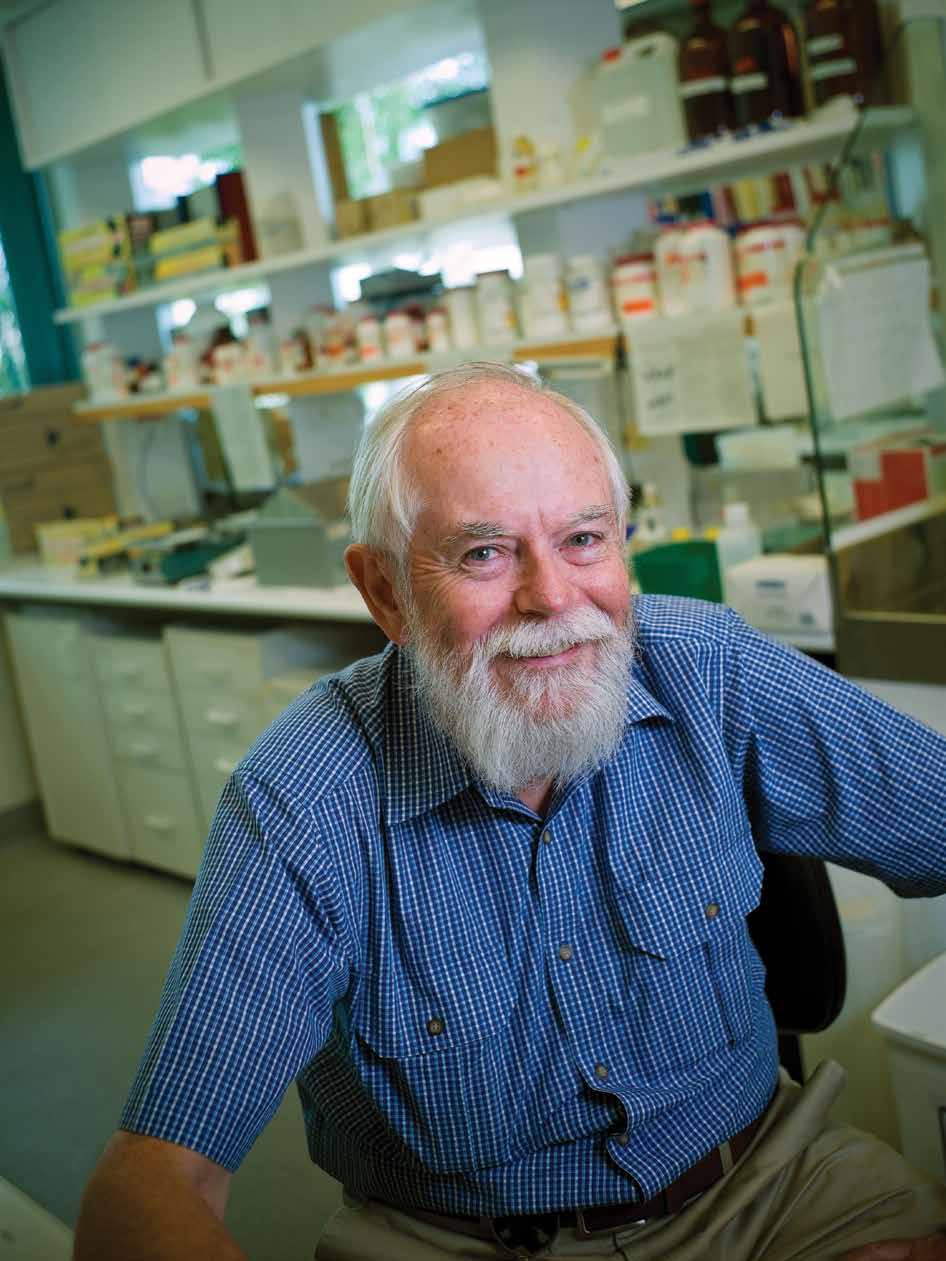












PROFESSOR PAT HOLT
SWITCH ON THE IMMUNE SYSTEM EARLY
How Professor Pat Holt changed what we thought we knew about asthma
Findings by Professor Pat Holt revealed researchers worldwide had been heading down the wrong path and needed a complete turnaround in their battle strategy against respiratory allergy and asthma.
His work at the Telethon Kids Institute was crucial to the realisation that the key to guarding against such disease lay in aiding the maturing immune system of the infant to “switch on” a protective mechanism which actively suppressed the development of allergic sensitisation.
This normally occurred through early exposure to potential allergy-causing inhaled particles, during the first few years of life.

Up to this point, the advice had been to reduce the child’s exposure to environmental airborne particles, such as dust mites and pollen, as much as possible, particularly in the home.
Through Professor Holt’s work, it was also understood that the complete or partial failure to “switch on” this protective tolerance mechanism in early childhood could lead to the progressive build-up of a harmful immune response that persisted into adulthood and could cause asthma and chronic hay fever.
It also helped reveal that children in families prone to allergic asthma have a tendency for slow maturation of immune function during infancy, resulting in a reduced capacity to develop this protective tolerance.
The key discovery was when Professor Holt proved that the main cause of respiratory allergy was not due to the “leakiness” of protective barrier membranes lining the airway surfaces in the lung, as had been widely thought. Up to then, it had been believed that this “leakiness” enabled proteins leached from inhaled particles to penetrate into the body, wrongly coming in contact with the immune system and triggering an inflammatory response in susceptible individuals.
He showed that the normal response of the body to inhalation of airborne particles that can trigger
respiratory allergy and asthma is the development of highly specific anti-inflammatory immune responses known as “immunological tolerance”. These suppress the production of the airborneparticle-specific IgE antibodies that are responsible for allergic symptoms.
“So we realised instead of passive protection via the barrier function of respiratory membranes, the basis for natural resistance to allergies was a highly specialised active immune response mediated by aeroallergen-specific T-lymphocytes known as T-regulatory cells,” he said.
Other Institute discoveries about “switching on” the protective tolerance mechanism in infants and the slow-maturing immune systems of at-risk families then followed.



In 1999, Professor Holt was presented with the King Faisal International Prize for Medicine, one of the world’s pre-eminent scientific awards, in recognition of his significant contribution to the improved understanding of asthmatic disease.
The implications of this improved understanding are far reaching.
Professor Holt’s work has stimulated multiple paediatric research programs around the world seeking to pinpoint the maturation defects in the immune systems of infants at high genetic risk of early onset allergies, and to find ways of speeding up maturation.
It also led to his team at the Telethon Kids Institute uncovering the existence of a highly sophisticated “immune surveillance” mechanism that operates within the airway lining membranes of the lung. This involves the activity of a network of specialised cells called Dendritic Cells, which are now recognised as the “gate keeper” of the immune system in the lung. This cellular network scans for incoming inhaled particles foreign to the body and helps direct the immune system on how to respond.
Most importantly, Professor Holt’s work has provided the basis for a fundamentally new
RESEARCH MAKING A DIFFERENCE | 37
PARADIGM SHIFT
approach to asthma prevention in childhood. It has led to the establishment of asthma prevention trials involving “controlled stimulation” of specific immune responses to stimulate the protective tolerance mechanism in at-risk young children, with the aim of permanently suppressing IgE production. Proof-of-concept and safety trials have been carried out recently in the USA and Australia, with support from the US National Institutes of Health. Follow-up efficacy trials of the concept are currently underway in the UK, with additional larger scale trials in late planning stage in the US.
Looking back on his decades of research at the Telethon Kids Institute, Professor Holt said there were “lots and lots of key moments that stand out”, with some that were “really quite profound”.
Starting off his career in biochemistry, he turned down a position at the US National Institute of Environmental Health Sciences in the late 1970s, when the lung research work he started in a temporary job at the University of WA microbiology department became “too interesting to pass up”.
He was then persuaded to turn his attention to lung inflammatory diseases in children, by Professor Keven Turner, the director of the Children’s Medical Research Foundation, which was the forerunner of the Telethon Kids Institute.
Moving on to the Institute then provided him with the opportunity for “significant clinical interactions”, with 65 per cent of the work done by his research group being patient-based.
“We collaborate with respiratory physicians and paediatricians who run clinics and help them design all manners of studies based on the use of human samples - in particular cells and fluids and things that can be washed out of the lungs of kids or are present in blood samples,” said Professor Holt. “And we study the immunological mechanisms that are responsible for the lung inflammation that brings these kids into the clinics.”
The unique environment of “co-operation and shared-approach” at the Institute also enabled him to join forces with epidemiologists to ensure a better match up between what was being asked and measured in population studies and what was seen in the laboratory.
“One example is a study called the Childhood Asthma Study, in which we tracked the


development of asthma in a group of about 240 kids who had come from asthma-prone families,” said Professor Holt.
“We tracked them all the way until they were 10 years of age, getting blood samples from them every year and having the physicians look very closely at the various sorts of respiratory diseases they had. Then back in the lab, we were trying to make sense out of what their immune system was doing in relation to driving these diseases.
“It was among the most important of all the studies that we have done and is still yielding exciting new data on how asthma develops, more than 10 years after sample collection was completed.”
Professor Holt says it has got to the point in his career now where he is spending less time in the lab and increasingly more time in front of the computer and on a plane, arguing the case with regulatory agencies, pharma companies and clinical academic colleagues, for increasing research targeted at asthma prevention in young children, rather than continuing to develop more drugs to treat the disease after it is established.
“Lots of my inspiration has been associated with globetrotting and talking to people in the US and Europe who are doing similar things to what we are doing,” he said. “Forming collaborations with people outside Australia and linking them in with what we are doing and us getting linked in to what is happening overseas.
“Increasingly, things are not done in isolation. If you are going to be internationally competitive, you basically need to be involved in programs that are based all over the planet.
“The main thing I am involved in at the moment, is trying to see the translation of some of the things that have come out of our research into practical spin-offs in the clinic.”
What’s next?
“Increasingly, knowledge gained is being focused on new therapeutic approaches for prevention of asthma and allergy in ‘at-risk’ children,” said Professor Holt. “I am involved in multiple academic and pharmaceutical collaborations in Australia, US and Europe, in projects which aim to develop and field-test these new therapies.”
38 | IMPACT
A highly sophisticated early warning surveillance mechanism operating in the airway surfaces of the lung that alerts it to invaders and signals the immune system on how to respond was discovered by the Telethon Kids Institute.
Professor Pat Holt and his team discovered the web-like Dendritic Cell network in the lung’s delicate lining membranes in airways that is responsible for scanning for and trapping incoming “foreign” proteins that get deposited there as we breathe. This includes potential allergy-causing pollen grains and viruses and bacteria capable of damaging tissue.
Recognised as the ‘ultimate gate keeper’ of the lung immune system, the Dendritic Cells are central to the protection against the damaging effects of common lung and airways disease and have become important targets for drug development.


They trap any proteins that penetrate into the membranes and also take fluid samples from the external airway surface. They then move into nearby lymph glands and present these samples to the immune system, along with encoded molecular signals that identifies the cargo as “friend or foe” and suggests when ‘tolerance’ rather than ‘active immunity’ is the appropriate response.

They also help the immune system not to get carried away and damage tissue, through programming the activity of antiinflammatory regulatory cells that control the intensity of immune responses.
They were identified at the Institute after initial insights were gained from experiments in the 1980s and confirmed in tissue studies in the 1990s.
Before Professor Holt’s discovery, it was believed that populations of cells known as ‘alveolar macrophages’, that patrol the external surfaces of the airway lining membranes, performed these vital surveillance functions. But there was no satisfactory explanation available for how they could signal through to the body’s immune system once they had migrated out onto the lung surface.

RESEARCH MAKING A DIFFERENCE | 39
PROFESSOR PAT HOLT WITH PHD STUDENT DELIA NELSON IN THE EARLY 1990’S
TREAT EARLY TO PROTECT LUNGS Research transforms approach to cystic fibrosis
Early intervention is being touted as the key to preventing lung damage in children with cystic fibrosis.
The Australian Respiratory Early Surveillance Team for Cystic Fibrosis (AREST CF) was formed in 2004, under the overarching premise that minimising lung damage in early childhood was the best strategy for reducing its impact later in life.
In his role as principal investigator, Professor Stephen Stick from the Telethon Kids Institute has focussed attention on early manifestations of CF lung disease in children aged under seven.
“We have identified inflammation in the lungs as a key factor in the progression of early lung disease and have developed new ways to monitor disease progression,” he said. “These findings have been incorporated into the first clinical trial to prevent lung disease in children diagnosed with CF following newborn screening.
“Despite appearing healthy and having few symptoms, the majority of six-year-old children with cystic fibrosis already have progressive lung disease and subtle changes in lung structure are evident in children from three months of age.”
Cystic fibrosis is one of the most common fatal hereditary diseases, with more than half of patients dying before the age of 50.
Caring for a child with CF takes a toll on families, with up to four hours a day needed for various treatments, including multiple medications and a special diet.
“Surprisingly little is known about the role of antibiotics and their effectiveness for prevention of lung disease in early life,” Professor Stick said.
“Our studies in the first years of life are identifying which bugs are most likely to be causing problems and this will help us design trials of antibiotics in this age-group. In older children, antibiotics combined with regular physiotherapy are the cornerstones of therapy that reduce the impact of chronic inflammation, mucous obstruction of airways and infection.”
Professor Stick said bronchiectasis, which is destruction of the airways in the lung due to chronic inflammation and infection, was once
thought to be a process that usually affected children beyond adolescence.
But the AREST CF researchers have demonstrated problems much earlier.
“We have observed using CT scans of the lungs that bronchiectasis can occur in children as young as three months and by five years of age the majority of children have evidence of bronchiectasis, albeit only affecting small areas of lung,” Professor Stick said.
The team has also discovered that children with neutrophil elastase, a potentially damaging by-product of inflammation, in their lungs at three months are at higher risk of developing bronchiectasis by the age of three.
“We have developed special techniques that can detect disease that affects as little as 2-3 per cent of the lung using ultra-low doses of radiation and sensitive image assessment tools,” he said.
“This realisation has caused a paradigm shift in our approach to management with a focus on prevention, early detection of lung damage and development of strategies to prevent lung damage.”
With improved detection and treatment, researchers believe CF lung disease can be prevented rather than ameliorated.
What’s next
Professor Stick, who also heads Respiratory Medicine at PMH, said in the next five years, it was hoped to:

• Identify new treatments that reduce inflammation that can be used to prevent lung disease.
• Develop simple tests that help monitor lung disease in the clinic and for clinical trials.
• Expedite clinical trials in young children, a group that have been neglected by the pharmaceutical industry.
• Investigate the plausibility of new gene repair technique to treat the basic genetic defect.

| IMPACT
What is cystic fibrosis?









• Cystic fibrosis affects the lungs and digestive system because of a malfunction in the exocrine system, responsible for producing saliva, sweat, tears and mucus. There is no cure.




• People with cystic fibrosis develop an abnormal amount of thick and sticky mucus within the lungs, airways and digestive system. This mucus traps bacteria in the lungs resulting in recurrent infections. Lung failure is the major cause of death.
• Cystic fibrosis affects one in every 2500 babies born in Australia.













• The CF gene must be inherited from both parents - and it is carried by one in 25 people.
 PROFESSOR STEPHEN STICK WITH KIAH WHO HAS CYSTIC FIBROSIS IN THE CLINIC AT PRINCESS MARGARET HOSPITAL
PROFESSOR STEPHEN STICK WITH KIAH WHO HAS CYSTIC FIBROSIS IN THE CLINIC AT PRINCESS MARGARET HOSPITAL
PARADIGM SHIFT
CHANGING THE FOCUS OF CEREBRAL PALSY
Problems tracked to earlier in pregnancy
Many parents of a child with cerebral palsy are baffled about what caused the condition and worry that they are at higher risk of it occurring again.
Finding the answer to their concerns has long been a research focus of Professor Fiona Stanley, who set up in the late 1970s what is now one of the longest-standing cerebral palsy registers in the world.
Her team at Telethon Kids Institute, including Associate Professor Eve Blair, contributed to a significant discovery. Cerebral palsy is not only the result of birth trauma and the lack of oxygen supply during delivery, widely accepted as the cause by the medical fraternity for over a century.

They found that greater intervention at birth, such as performing more caesarean sections, was not reducing the birth prevalence of cerebral palsy, as had been anticipated by obstetricians.
Instead most cases were linked to events earlier in pregnancy which disrupted normal brain development.
This finding enabled the focus to shift away from birth, and stem the tide of litigation that was plaguing the obstetric field.

“Eve really led this work with a major case-control study comparing risks for CP kids and other kids and we published extensively on how few children were likely to have received their brain damage at birth,” Professor Stanley said.
“It not only showed that causes of cerebral palsy were rare in labour but it highlighted that cerebral palsy is made up of many different syndromes and that we needed to look earlier in pregnancy if we were to shed light on cause.
“Our data were used extensively in obstetric litigation cases and we made the case over 20 years ago for a national disability no-fault insurance scheme. This finding also shifted research into earlier periods of pregnancy – which is challenging since it is hard to measure risks in utero.”
Associate Professor Blair said she did not think a cure was a possibility in the foreseeable future

42 | IMPACT
2001: THREE-YEAR-OLD SOPHIE MANNING WHO HAS CEREBRAL PALSY WITH DR EVE BLAIR AND PROFESSOR FIONA STANLEY. PHOTO COURTESY THE WEST AUSTRALIAN
but it was important to keep chipping away at the causes with a view to prevention and encourage women to make healthy lifestyle choices.
“The misconception that birth asphyxia is the major cause of CP is still rife,” she said. “The baby assists in the birth process – a compromised infant, particularly a neurologically compromised infant, is likely to have more difficulties during birth because it does not assist appropriately. Therefore many children who later are labelled as CP do have some difficulties during birth, but usually they are insufficient to damage a normal infant.”
Prematurity and low birth weight are also associated with higher rates of cerebral palsy.
Professor Stanley said the WA Cerebral Palsy Register, which is run by Linda Watson, was established to answer the key question of whether the dramatic increase in survival of preterm infants had resulted in an increase in children with cerebral palsy.
“We found that it had and that it was a function of how many children at each gestational age died or survived,” she said.

“More understanding of the pathways into preterm cerebral palsy and how this might be reduced by improvements in neonatal intensive care has meant that the proportion of very preterm infants with cerebral palsy is now falling.
What is cerebral palsy?
Cerebral palsy is defined by motor disability due to damage of the developing brain and is frequently accompanied by other neurological impairments such as intellectual or sensory. It is the most common physical disability in childhood, affecting about one in 500 children.
Decades of records
The WA Cerebral Palsy Register was set up in 1977 to monitor incidence of the condition, enable research into the causes and assist in the planning of services for people with cerebral palsy. It records cases of cerebral palsy for people born or living in WA from 1956 onwards. It has since been incorporated into the Western Australian Register of Developmental Anomalies.
“The rates of cerebral palsy are still closely related to how early you are born and whether you have restricted growth in utero, suggesting other causes than just being born early.
“Since our register was set up, many possible causal factors have been identified and there is increasing research interest now in all these problems and how to prevent them.” These factors include neuronal migration disorders, genetic syndromes, genetic propensities, teratogens, multiple pregnancy, inflammation, thrombotic disorders, intra-uterine strokes, infections and head trauma after birth.


Kerry Naso, the mother of 22-year-old David who raised awareness of cerebral palsy as the Telethon child in 2001, cannot speak highly enough of the work of these cerebral palsy investigators.
A parent representative to the Telethon Kids Institute, Ms Naso said it was a shock when David was diagnosed at 11 months of age. She admitted she did blame herself at the time, wondering if it was the vitamins she’d taken.
“I would love to hear in my lifetime the reason why,” she said. “It would be so great if they could just come out and say it was not something that the mum did. I lived with that guilt, having had two kids with disabilities.
“After a while though, you don’t blame yourself anymore, you just try to make the best of things for your child.”
What’s next
According to Professor Stanley, collating more data is crucial.
“I think that the register must continue to monitor the trends in cerebral palsy, in all the different syndromes and to ensure that the CP registers across Australia are analysed together as they are more powerful the larger the numbers that you have.
“There is increasing interest in the role of genetic risks in cerebral palsy and this needs large numbers such as in the national data.”
RESEARCH MAKING A DIFFERENCE | 43
PARADIGM SHIFT
A CELL CHANGE THAT DRIVES LEUKAEMIA
Discoveries towards better treatments
When a local five-year-old boy was diagnosed with a particularly aggressive form of leukaemia, T-cell acute lymphoblastic leukaemia, Telethon Kids Institute researchers were among the team that discovered a critical chromosomal change in his cells never before reported.
Together with collaborators Professor Margaret Garson in Melbourne and Professor Terry Rabbitts in Cambridge, UK, they identified the HOX11 gene, found to be an important oncogenic driver in leukaemia.
“It is a master control gene, so when it is deregulated it changes a normal cell to a malignant cell, in combination with not-yetunderstood additional changes,” said Institute researcher Professor Ursula Kees.
It was the early 1990s and Professor Kees had been working with the Princess Margaret Hospital Oncology Ward to improve understanding of childhood cancers and find better treatments.
“Our discovery changed thinking and led to many studies to decipher the mechanisms that lead to leukaemia,” Professor Kees said.
“Back then, we wanted to identify the genes at the chromosomal breakpoints. To do it, we collaborated with Professor Rabbitts in Cambridge.
“This work identified the HOX11 gene at the breakpoint and provided insight into the molecular events that lead to this critical change.”

It is now known that the HOX11 gene is permanently activated in the leukaemia cells and it drives the disease.
“In subsequent studies, we found that HOX11 activation is exclusive to T-cell acute lymphoblastic leukaemia (T-ALL) and does not occur in the more common form of B-lineage ALL, which about 80 per cent of childhood ALL patients have,” said Professor Kees.
“We also discovered that there must be other mechanisms, than chromosomal changes, that lead to activation of HOX11, and we studied the molecular mechanisms.
“We then embarked on a large collaborative study with the US-based Children’s Oncology Group
(COG), which we have been a member of since 1990 and now involves the participation of 240 hospitals around the globe.

“Our study showed that HOX11 activation is widespread in T-ALL, and that it has potential as a prognostic marker.”
The HOX11 gene work was funded by the Children’s Leukaemia and Cancer Research Foundation, Perth.
What’s next?
“Another big study in collaboration with COG is under way, to find better diagnostic methods for patients with T-ALL,” Professor Kees said.
“It started more than four years ago and is progressing well. We are using whole genome methods and are investigating large patient cohorts enrolled on COG therapy studies.
“We still urgently need to find better ways of treating our patients. For many children with leukaemia, we have good therapies, although they have serious long-term effects. But we are nowhere near it for other patient groups – for example babies with leukaemia.”
About leukaemia
Leukaemia is the most common form of cancer in children, accounting for around one third of all cases.
Leukaemia affects around one in every 2,000 children in Australia and it is more common in boys than girls with a 1.4 to 1 ratio. There is a peak incidence in children aged between two and four years.
Survival rates for children with leukaemia have reached up to 85 per cent for patients of standard risk.
| IMPACT







RESEARCH MAKING A DIFFERENCE | 45
PARADIGM SHIFT
DR PATTY WASHER, ASSOCIATE PROFESSOR ALEX BEESLEY AND PROFESSOR URSULA KEES


46 | IMPACT
IN THE PIPELINE



RESEARCH MAKING A DIFFERENCE | 47
AUTISM TEAM: ALENA DASS, MARYAM BOUTRUS, GAIL ALVAREZ, ANNA HUNT, JO GRANICH AND PROFESSOR ANDREW WHITEHOUSE



48 | IMPACT
EARLY DIAGNOSIS FOR KIDS WITH AUTISM
Why identifying subtle symptoms in babies could change their lives
Focussing attention on a child’s first year of life is proving to be a major breakthrough in autism research.
Professor Andrew Whitehouse said this very early intervention was the new frontier and provided hope for a long-term reduction in disability.
“By providing therapies in the first year of life, we may be able to make even greater gains than we thought, like helping a child to develop language where they may not otherwise have done so,” he said. “That is truly life-changing.”
The head of the Autism Research Team at the Telethon Kids Institute said its goals were to discover the causes of autism spectrum disorders and find ways to help these people live the most fulfilling lives possible.
He was drawn to the field in 2001 during his undergraduate studies in speech pathology, when the son of a family friend was diagnosed with the learning and behavioural disorder.


“I was captivated by the struggle of the family, firstly the recognition that something was different with their child, secondly the struggle to get a diagnosis and thirdly the struggle to find therapy, and all the while grieving for the hopes and dreams of their child that may never be fulfilled,” he said.
“I thought if I could dedicate my working life to this, it would be a life well spent.”

In the 14 years since, understanding about autism has come along in leaps and bounds.
“When I started out, autism was considered one disorder with one cause,” Professor Whitehouse said. “We now know that there are many different causes of the many different types of autisms. We are no longer looking for one cause, we are looking for dozens upon dozens of causes.”
For about 15 per cent of autism cases, it is known what caused the brain to develop differently - about 20 causes have been pinpointed. “The other 85 per cent that remain are the mystery that keeps me going,” Professor Whitehouse said.
Recognising autism as a range of multiple disorders makes it easier to tailor intervention programs to the individual.
Autism is diagnosed based on behaviour and the earliest it can usually be picked up is around two or three years of age.
But the fledgling practice of targeting early signs of autism in the first 12

RESEARCH MAKING A DIFFERENCE | 49
IN THE PIPELINE
months of life, which has been backed up by a recent British study, has Professor Whitehouse excited.

“What we have contributed to the international effort is that you can actually start identifying symptoms - more subtle symptoms - before the age of two or three,” he said. “In the first year of life, the brain is so changeable, more so than at any other time in our lives.
“By helping to identify risk factors in the first year of life, irrespective of the causes, we can say ‘there’s a child with that red flag’ and start to provide intervention and it will reduce their disability later in life. We can shift the brain back on to a more typical neurodevelopmental path.
“The hope is that children who may never have been able to talk will be able to develop language and social relationships, go through school, get a job and have a happy and healthy life.”
What is autism?
With so much research focused on children with autism, Professor Whitehouse has also developed an assessment for adults which is now used internationally.
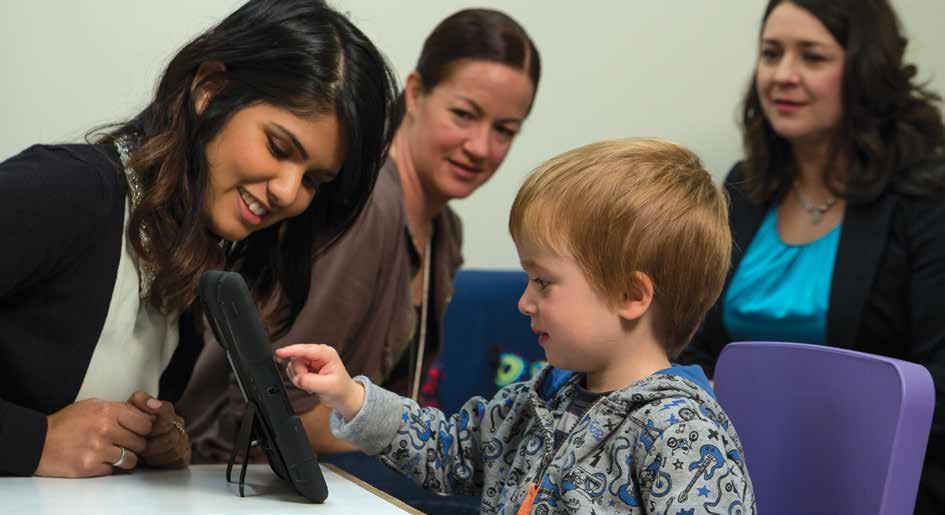
What’s next?
His team was the first in the country to create a biological registry for autism, which directly led to the creation of the new Australian Autism Biobank by Cooperative Research Centre (CRC) for Living with Autism.
With genetics playing a key role, the biobank will store information collected from more than 1200 affected families.
According to project leader Professor Whitehouse, it will allow “unprecedented biological discovery” into autism and hopefully push that 15 per cent with known causes up to 30-40 per cent.
Autism is a developmental condition characterised by difficulties in social interaction and communication. People with autism can display very different behaviours depending on where they fall on the spectrum — some are high-functioning, while others may be intellectually disabled and non-verbal.

• One in every 100 children in Australia is diagnosed with Autism Spectrum Disorder - a 25-fold increase over the past 50 years.
• Autism affects about four times as many boys as girls.
• There is about a 20 per cent chance that if one child has autism, another sibling will too.
50 | IMPACT
RESEARCH ASSISTANT ALENA
DASS SHOWS HAYDEN HOW TO USE THE APP, WATCHED
BY MUM KRISTIE AND TRIAL COORDINATOR JO GRANICH
LOOKING AT LANGUAGE

What twins are teaching us about how we learn to talk
Hearing your child’s first word is a precious moment for any parent but while most children begin to talk within 12 to 24 months of age, some take much longer.
Parents are naturally concerned when their child is not talking. They want to know why, will they eventually catch up and what impact it will have on their child’s future?
In a world’s only study called ‘Looking at Language’, researchers at the Telethon Kids Institute are working on answering those questions. For the past 15 years they have been collecting and analysing data from more than 5000 West Australian children aged 2 – 14 years, including 700 sets of twins.
Their research has found 13 per cent of two-yearolds, with otherwise healthy development, are late to start to talk.
Lead researcher Professor Cate Taylor said that while the majority of preschool-age children caught up down the track, one in five late talkers continued to have language difficulties in the school years. The problem is that we cannot predict which children will catch up and which children will continue to have language difficulties.
“Language really is at the heart of everything we do – it is a tool for life. Without good language skills, things we take for granted, like making friends, doing well at school, are a challenge,” Professor Taylor said.
Now that Telethon Kids Institute researchers have discovered how many children experience language impairment, they want to know the reasons why.

“While there is no dispute about the crucial role that parents play in their children’s language development, we do know that neurobiology and genetics play an important role in learning to talk.
“While we don’t yet know exactly how, we do know that language impairment is not caused by a deficiency in the child’s language learning environment. In other words, parents don’t cause language impairment.”
What is late language emergence?


Late language emergence is when a child’s language is below age and gender expectations, that is, they speak few words and do not join words together to form sentences.
Professor Taylor said her team’s research had found that children’s language can fall behind at many different stages of their development and a one off screening at one particular age was not going to be sufficient to identify problems.
“Children need to be screened at different stages throughout their school years,” Prof Taylor said. “Once a language delay is identified, we then need to have a system in place to help bring these children up to the same level of their peers,” Prof Taylor said.
What’s next?
The children in the ‘Looking at Language’ study are now 14. Professor Taylor said her team would like to continue to monitor their progress through to the end of their school years and into their chosen career. “We want to know exactly how language development impacts on a child’s academic and career success,” she said.
Professor Taylor also said her team would like to work with government and the health and education workforce to develop a universal system for monitoring children’s language development in childhood and adolescence and provide services and supports that lift health and education standards for all children in Australia
RESEARCH MAKING A DIFFERENCE | 51
PROFESSOR CATE TAYLOR WITH TWINS ERIKA AND CHLOE
A VACCINE TO PROTECT KIDS HEARTS
The international e ort against Group A Strep

The Telethon Kids Institute is spearheading a transTasman effort to develop a vaccine for rheumatic fever.
Institute director Professor Jonathan Carapetis said a vaccine would be a game-changer for this illness, which is caused by a group A streptococcus infection. What starts out as a sore throat can lead to permanent heart damage, known as rheumatic heart disease.
Continuing the work he did at the Menzies School of Health Research in Darwin, Professor Carapetis’ focus is on finding ways to prevent and better treat rheumatic heart disease in Australia.
Aboriginal, Torres Strait Islander, Maori and Pacific Islander populations have some of the highest rates of rheumatic heart disease in the world.
In remote communities, about 3-5 per cent of Aboriginal people will have the condition and the average age of death from it is in the 30s.
“In these areas, everyone knows someone who has got it or died of it,” Professor Carapetis said. While treatments for patients are improving, it is far better to stop the disease from occurring in the first place.
Finding an effective and economically viable vaccine is the primary aim of the governmentfunded partnership between Australia and New Zealand, called the Coalition to Advance New Vaccines for Group A Streptococcus (CANVAS).

Professor Carapetis said the main obstacles standing in the way of a vaccine before now revolved around market and safety doubts.
“Our main goal is getting a vaccine through the early stages to make it much easier for pharmaceutical companies to get involved,” he said.
“By the end of this year, we will have evaluated three potential vaccines for their likelihood of being effective. We will also have compiled a definitive collection of the types of bacteria that we want a vaccine to prevent against and we will also have made an analysis of the economic case for investing in the vaccine.”
This will enable them to go back to the two governments to ask for a bigger financial
commitment for the next stage.
“We want to be able to take at least one vaccine through to demonstrating that it can prevent strep infection in the throat and try to get the pharmaceutical industry engaged into taking it right through to be a rheumatic fever vaccine,” he said.
“This is absolutely a game-changer if we can make it happen.
“It is the first time for me in more than 20 years that I’ve been able to say that I think we will have a rheumatic fever vaccine in my lifetime.”
A vaccine will make the world of difference to Aboriginal kids living in rural and remote parts of the State.
Janice Forrester, clinical nurse manager at the WA Rheumatic Heart Disease Control Program in Broome, sees first hand the difficulties faced by families in the wake of a child having acute rheumatic fever.
Those needing immediate cardiac care have to be airlifted to Perth to be admitted to Princess Margaret Hospital. A caregiver who goes with them might find themselves living away from their community - and other children - for months.
Ms Forrester said it could also be onerous on the patient to keep coming back into a clinic for longterm treatment and it was often difficult to convey the importance of having penicillin injections every 28 days.
“A vaccine that would protect someone against group A strep would cut out the necessity of having to have these regular injections. It would
What is rheumatic fever?
• Rheumatic fever is caused by an immune reaction to infection with the group A streptococcus bacterium and targets several parts of the body, including the heart, joints, brain and skin. An acute episode or recurring rheumatic fever can cause irreparable damage to the major cardiac valves.
• Children aged between 5 and 14 are most likely to get rheumatic fever.
• The only effective way to stop rheumatic fever recurring is to have monthly penicillin injections, for 10 years or until the patient has turned 21.
52 | IMPACT
provide cover for kids who would be vulnerable to getting acute rheumatic fever should they be exposed, so essentially it would help cut out the necessity for young people to have these interactions with clinics and have to deal with chronic disease.”
The Australian experience of acute rheumatic fever has also played a pivotal role in the recent revision of the American Heart Association’s (AHA) internationally accepted criteria for its diagnosis.

Professor Carapetis, who participated on the panel that wrote the new “Jones Criteria”, said because the disease had become rarer in the United States, the AHA had repeatedly changed the criteria over several decades, each time becoming stricter. This meant that many patients in places such as Australia were simply not meeting the criteria, even though they were likely to have rheumatic fever. As a result, Australia developed its own criteria in 2006, which made it easier to diagnose in indigenous people.
“For the first time the AHA recognised that our Australian approach has merit, that you need to have different criteria for people who come from populations with a lot of the disease,” he said.
The Telethon Kids Institute also contributed to a Menzies project that looked into the issue of group A strep and skin sores.
“If you go to a remote community, from 30 to 70 per cent of Aboriginal kids might have skin sores at any one time, which can lead to serious complications such as kidney disease, blood infections and rheumatic heart disease,” Professor Carapetis said.
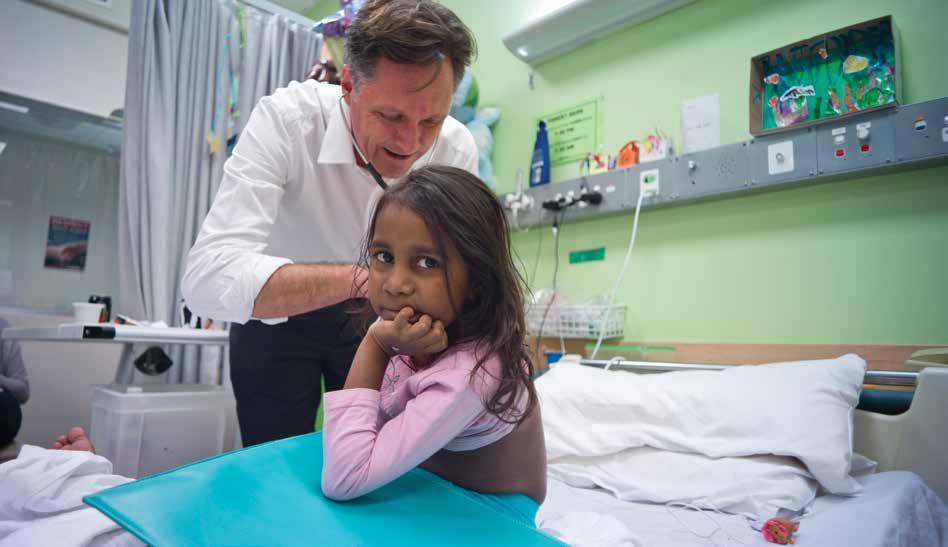
The trial in the Northern Territory found that instead of relying on painful penicillin injections to treat skin sores, offering tablets or medicine of another widely available antibiotic could treat strep as effectively and was much better tolerated. This is now being incorporated into guidelines around Australia and, hopefully, around the world.


What’s next
• A national collaboration to strategically target research to define how we can eliminate rheumatic heart disease as a significant health problem in Australia. The new END RHD CRE program will aim to have a report ready within five years to provide a roadmap of how to get rid of this disease.
• More focus on talking to affected people to understand the lived experience of rheumatic heart disease and how they can take better control of their own health.
RESEARCH MAKING A DIFFERENCE | 53
PROFESSOR JONATHAN CARAPETIS WITH RHEUMATIC HEART DISEASE PATIENT LAQUEISHA AT PRINCESS MARGARET HOSPITAL
DELIVERING SMART DRUGS INTO CELLS
Our researchers at the new frontier of drug discovery

Finding a far more reliable “piggyback ride” for smart drugs that can penetrate deep into cells and attack their disease targets in the cytoplasm or nucleus while causing fewer side effects, has been a major breakthrough made by the Telethon Kids Institute’s Drug Discovery Unit.
Already these rare ride-offering cell penetrating Phylomer (CPPs) peptides, derived from the genomes of ancient bacteria and identified by local Institute researchers, have been shown to transport cancer-fighting inhibitors that turn off a
key “master regulator switch” for cancer, known as the Myc protein.

“Myc is a kind of ‘Holy Grail’ target in cancer,” said Dr Paul Watt. “People have been wanting to hit it with drugs for a long time, because it is known that many cancers become ‘addicted’ to the Myc protein and can’t survive without it.
It is a really important target for many types of cancer, including lymphomas, leukaemia and brain cancers.”

54 | IMPACT
DR RICHARD HOPKINS AND PROFESSOR PAUL WATT
Around a hundred billion compounds had to be genetically screened by the Institute to pinpoint less than 100 CPP peptides capable of “piggy backing” these safer cutting-edge smart drugs called biologics.
Biologics drugs, which include antibodies and toxins, are known to have fewer side effects and better binding capabilities than conventional drugs. However biologics are unable to penetrate into cells by themselves, which means they are unable to access the majority of drug targets (80%) which are found inside cells.
While other less-effective cell penetrating peptides have been used to transport biologics into cells, most remain trapped due to intracellular vesicles called endosomes and are unable to access the disease-causing targets.
Institute researchers Dr Paul Watt and Dr Richard Hopkins said they first realised they were on to “something big” when pharmaceutical industry giants Janssen (Johnson & Johnson) and Genentech (Roche) requested to join in on their work and access the new intracellular delivery method.
“We’ve already exceeded the efficiency of the gold standard intracellular delivery peptides by 37 to 160-times using our cell penetrating Phylomers,” said Dr Hopkins.
“This outcome allows us to make the bold claim we have the world’s best-in-class peptides for delivering smart drugs inside cells.
“Also, because the technology can deliver smart drugs to any disease target inside cells, it is not restricted to cancer. Many diseases involve deleterious combinations of proteins inside cells which could be targeted with this approach.”
The Drug Discovery Unit is now focused on research translation and drug discovery through its public biotechnology company Phylogica Limited. This company is a spin out from the Telethon Kids Institute and the US-based Fox Chase Cancer Centre in Philadelphia.


Phylogica has generated libraries containing over 400 billion unique natural peptides, optimised by evolutionary selection to adopt stable drug-like structures.

“These peptides come from the genomes of biodiverse bacteria which have been evolving for billions of years,” said Dr Watt.
“Their genes are so diverse because the microbes live in such diverse environments as deep sea volcanic vents, geysers and salt lakes.
“By making peptide libraries derived from these diverse organisms, we end up with very high quality ‘lego blocks’, which include virtually every shape found in nature that has been designed for the ability to bind to other proteins.
“Effectively we can now screen all of the structures developed by nature in a test tube.”
Phylogica offers drug discovery services to the pharmaceutical industry, allowing others to utilise libraries and screening technologies in exchange for licence fees, milestones and royalties. The company has entered into discovery alliances with several of the largest global pharmaceutical companies. In the past five years, this has included Roche, MedImmune, Pfizer, Janssen, Cubist Pharmaceuticals and the Roche subsidiary Genentech.
What’s next?
“Now that we have a handle on how to deliver smart drugs efficiently into cells, we are developing our own smart drugs against targets that have proved unreachable with conventional drugs,” said Dr Hopkins. “In many respects, the ability to deliver a new generation of drugs inside cells represents the last frontier in medicine and we’re excited to be at the forefront of developments in this field.”
RESEARCH MAKING A DIFFERENCE | 55
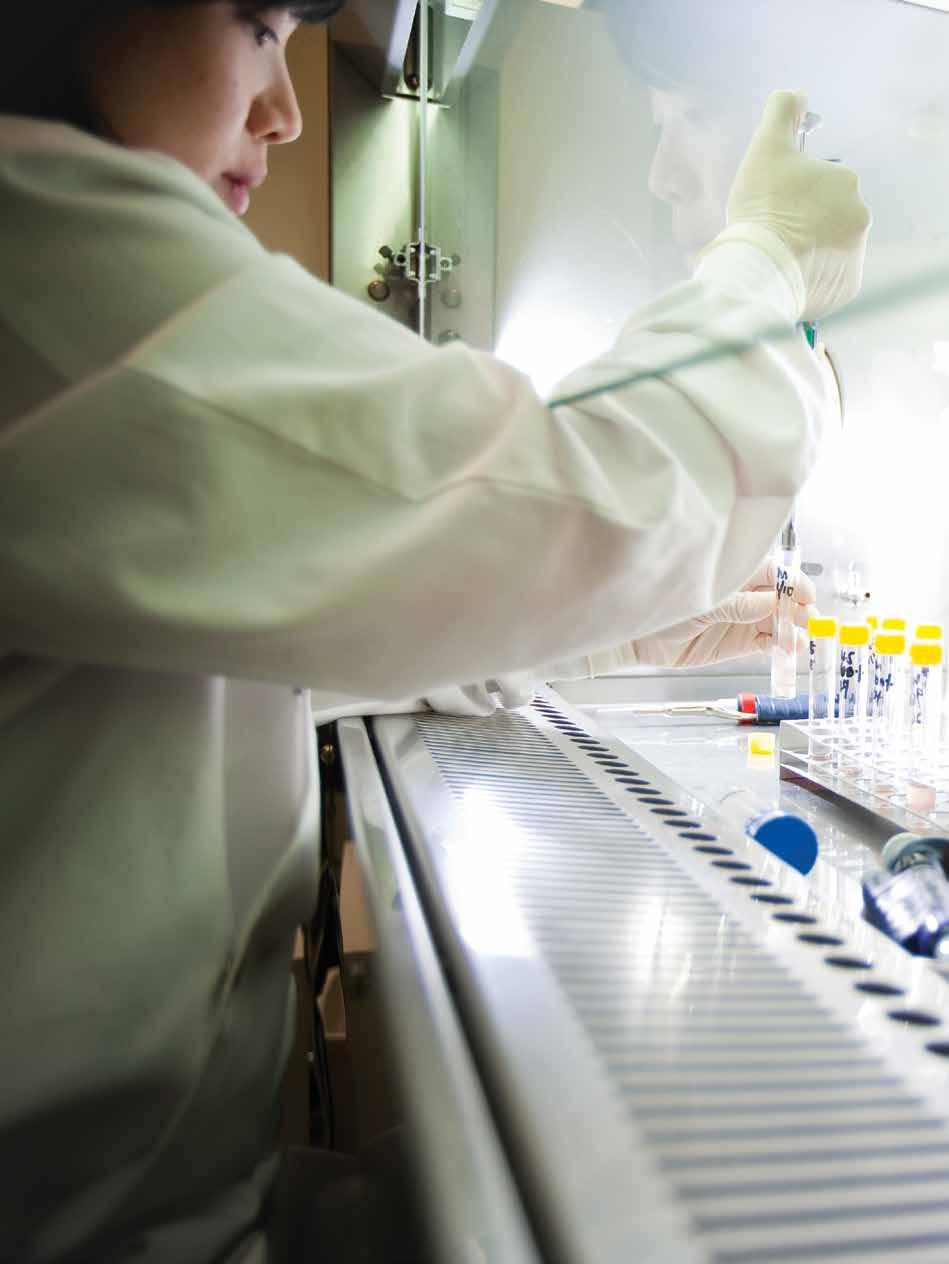
are at the of everything we do
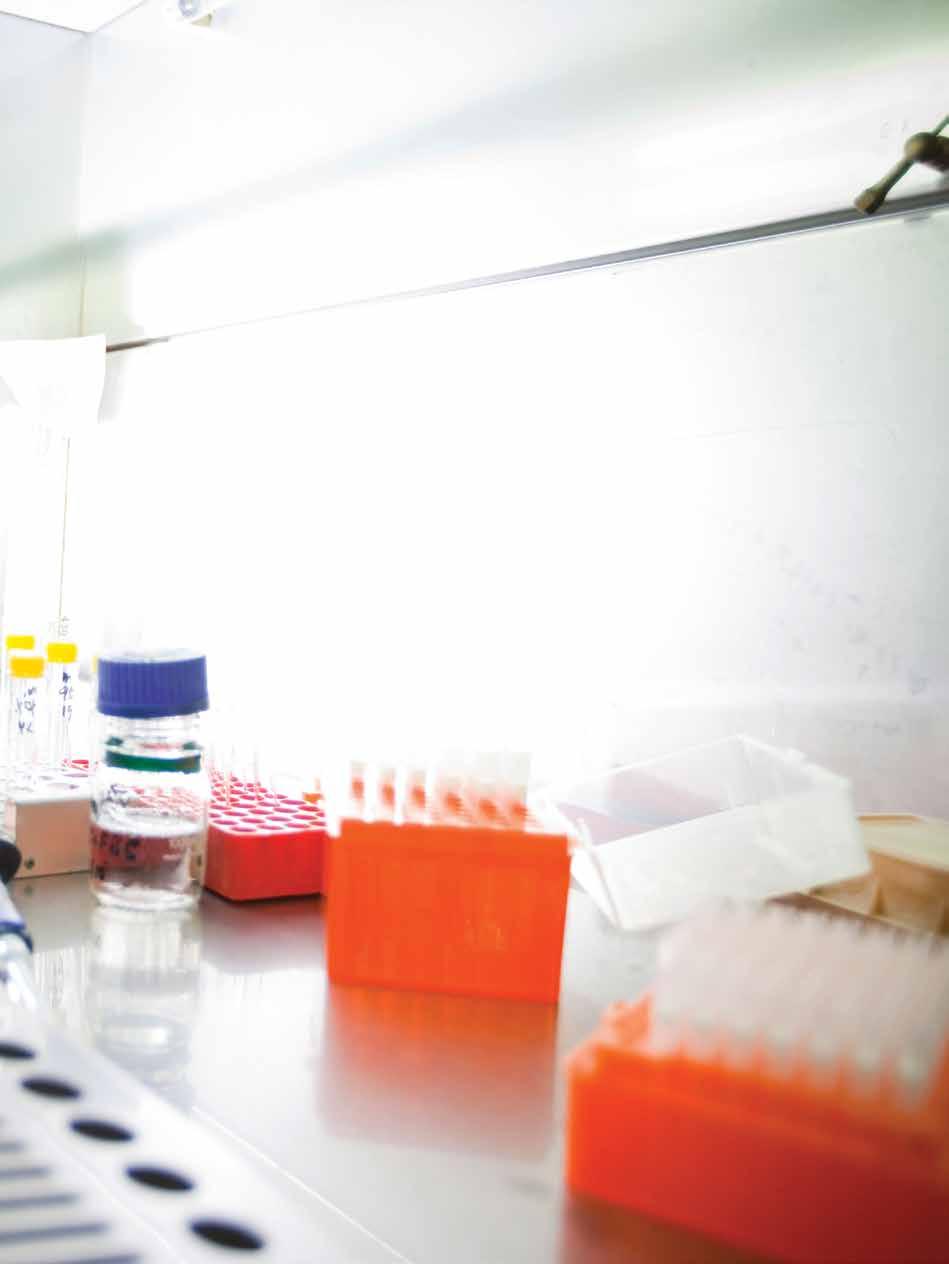
For further information about donating to the Telethon Kids Institute, subscribing to our mailing list or joining us for a tour of our facilities please contact us on: T | 08 9489 7777 E | contact@telethonkids.org.au W | telethonkids.org.au
100 Roberts Road, Subiaco Western Australia 6008
PO Box 855, West Perth Western Australia 6872
T | 08 9489 7777
E | contact@telethonkids.org.au
W | telethonkids.org.au
PRINCIPAL PARTNER
STRATEGIC PARTNER




















































































































































































































































































































































































































































































































 PROFESSOR STEPHEN STICK WITH KIAH WHO HAS CYSTIC FIBROSIS IN THE CLINIC AT PRINCESS MARGARET HOSPITAL
PROFESSOR STEPHEN STICK WITH KIAH WHO HAS CYSTIC FIBROSIS IN THE CLINIC AT PRINCESS MARGARET HOSPITAL
















